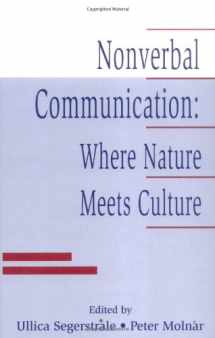
Nonverbal Communication: Where Nature Meets Culture
ISBN-13:
9780805821796
ISBN-10:
0805821791
Edition:
1
Author:
Ullica Segerstrale, Peter Molnar, Ullica Segerstr†le, Peter Moln r
Publication date:
1997
Publisher:
Psychology Press
Format:
Hardcover
320 pages
FREE US shipping
Book details
ISBN-13:
9780805821796
ISBN-10:
0805821791
Edition:
1
Author:
Ullica Segerstrale, Peter Molnar, Ullica Segerstr†le, Peter Moln r
Publication date:
1997
Publisher:
Psychology Press
Format:
Hardcover
320 pages
Summary
Nonverbal Communication: Where Nature Meets Culture (ISBN-13: 9780805821796 and ISBN-10: 0805821791), written by authors
Ullica Segerstrale, Peter Molnar, Ullica Segerstr†le, Peter Moln r, was published by Psychology Press in 1997.
With an overall rating of 4.3 stars, it's a notable title among other
Mental Health
(Social Psychology & Interactions, Psychology & Counseling, Communication, Words, Language & Grammar , Speech, Social Psychology & Interactions, Psychology, Communication & Media Studies, Social Sciences) books. You can easily purchase or rent Nonverbal Communication: Where Nature Meets Culture (Hardcover) from BooksRun,
along with many other new and used
Mental Health
books
and textbooks.
And, if you're looking to sell your copy, our current buyback offer is $0.33.
Description
The search for the biological foundations of human culture inevitably leads to nonverbal communication. Superficial intuition suggests that nonverbal communication is a sine qua non for the evolution of sociality. Without it, the diversity and sophistication of today's social systems would be unimaginable. However, there is the opposite hypothesis that the evolution of nonverbal communication may in part be the result of our being thoroughly social entities: Our sociality itself may have amplified the evolution of a capacity we share with other primates but have developed to a degree unequaled by any other species. Advances in the evolution of nonverbal communication as presented in this volume will certainly contribute to further insights into the intricacies of the biological and the social worlds. This volume grew out of a conference at the Center for Interdisciplinary Research in Bielefeld, Germany. The conference was organized by a research group working on the overarching theme of "Biological Foundations of Human Culture," so that scholars in such wide-ranging areas as biology, psychology, sociology, anthropology, economics, primatology, history, and philosophy of science could present and discuss recent approaches toward a biologically and sociologically founded understanding of human culture. This pluralistic perspective made it possible to bring the diverse disciplinary approaches into fruitful dialogue.


We would LOVE it if you could help us and other readers by reviewing the book
Book review

Congratulations! We have received your book review.
{user}
{createdAt}
by {truncated_author}


